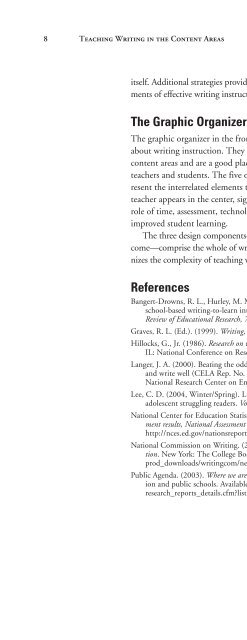How to Use It - ymerleksi - home
How to Use It - ymerleksi - home
How to Use It - ymerleksi - home
Create successful ePaper yourself
Turn your PDF publications into a flip-book with our unique Google optimized e-Paper software.
8 Teaching Writing in the Content Areasitself. Additional strategies provide further examples of the four interrelated elementsof effective writing instruction.The Graphic OrganizerThe graphic organizer in the front of this guidebook lists the five assumptionsabout writing instruction. They reflect key concepts of teaching writing in thecontent areas and are a good place <strong>to</strong> begin thinking about its benefits for allteachers and students. The five overlapping circles beneath the assumptions representthe interrelated elements that affect the quality of writing instruction. Theteacher appears in the center, signifying the importance of understanding of therole of time, assessment, technology, and practical strategies. The result isimproved student learning.The three design components—assumptions, interrelated elements, and outcome—comprisethe whole of writing instruction. This integrated approach recognizesthe complexity of teaching writing while keeping it manageable.ReferencesBangert-Drowns, R. L., Hurley, M. M., & Wilkinson, B. (2004, Spring). The effects ofschool-based writing-<strong>to</strong>-learn interventions on academic achievement: A meta-analysis.Review of Educational Research, 74(1), 29–58.Graves, R. L. (Ed.). (1999). Writing, teaching, learning. Portsmouth, NH: Heinemann.Hillocks, G., Jr. (1986). Research on written composition: New directions for teaching. Urbana,IL: National Conference on Research in English.Langer, J. A. (2000). Beating the odds: Teaching middle and high school students <strong>to</strong> readand write well (CELA Rep. No. 12014). Albany, NY: State University of New York,National Research Center on English Learning & Achievement.Lee, C. D. (2004, Winter/Spring). Literacy in the academic disciplines and the needs ofadolescent struggling readers. Voices in Urban Education, 14–25.National Center for Education Statistics. (2003, July). The nation’s report card: 2002 assessmentresults, National Assessment of Educational Progress. Available:http://nces.ed.gov/nationsreportcard/writing/results2002/National Commission on Writing. (2003). The neglected “R”: The need for a writing revolution.New York: The College Board. Available: http://www.writingcommission.org/prod_downloads/writingcom/neglectedr.pdfPublic Agenda. (2003). Where we are now: 12 things you need <strong>to</strong> know about public opinionand public schools. Available: http://www.publicagenda.org/research/research_reports_details.cfm?list=11
















